Understanding of BeCu Interaction Characteristics with a Variation of ns Laser-Pulse Duration
Abstract
1. Introduction
2. Experiments
3. Results and Discussions
3.1. Crater Size, Thermal Depth, Ablation Threshold, and Incubation Coefficient
3.2. Material-Removal Zone, Ablation Depth, and Full Penetration
3.3. Effect of Laser Parameters on Ablation Characteristics and Surface Morphology
4. Conclusions
Funding
Conflicts of Interest
References
- Golden, J.R.; Bernard, B.T. Coaxial Spring Contact Probe. U.S. Patent 5196789A, 23 May 1993. [Google Scholar]
- LEENO. Spring Contact Probe (ICT). Available online: http://leeno.com/products/spring-contact-probe/ (accessed on 10 July 2018).
- Tsui, C.M.S.; Sze, C.T.A.; Chan, S.K.D.; Wong, S.K.J. Spring Contact Probe Device for Electrical Testing. U.S. Patent 6967492B2, 22 November 2005. [Google Scholar]
- Lee, D.; Cho, J.; Kim, C.H.; Lee, S.H. Application of laser spot cutting on spring contact probe for semiconductor package inspection. Opt. Laser Technol. 2017, 97, 90–96. [Google Scholar] [CrossRef]
- Wang, X.; Zhang, D.; Gu, C.; Shen, Z.; Liu, H. Research on the micro sheet stamping process using plasticine as soft punch. Materials 2014, 7, 4118–4131. [Google Scholar] [CrossRef] [PubMed]
- Lee, D. Experimental investigation of laser ablation characteristics on nickel-coated beryllium copper. Metals 2018, 8, 211. [Google Scholar] [CrossRef]
- Steen, W.M.; Mazumder, J. Laser Material Processing, 4th ed.; Springer: London, UK, 2010. [Google Scholar]
- Lee, D. Experimental investigation of laser spot welding of Ni and Au-Sn-Ni alloy. J. Weld. Join. 2017, 35, 1–5. [Google Scholar] [CrossRef]
- Lee, D.; Pyo, S. Experimental investigation of multi-mode fiber laser cutting of cement mortar. Materials 2018, 11, 278. [Google Scholar] [CrossRef] [PubMed]
- Lee, D.; Mazumder, J. Numerical studies of laser cutting of an anode for Lithium-Ion batteries. In Proceedings of the 31th International Congress on Applications of Lasers & Electro–Optics, Anaheim, CA, USA, 23–27 September 2012. [Google Scholar]
- Lee, D.; Patwa, R.; Herfurth, H.; Mazumder, J. High speed remote laser cutting of electrodes for Lithium-Ion batteries: Anode. J. Power Sources 2013, 240, 368–380. [Google Scholar] [CrossRef]
- Herfurth, H.J.; Patwa, R.; Pantsar, H. Laser cutting of electrodes for advanced batteries. In Proceedings of the LPM, Stuttjart, Germany, 7–10 June 2010. [Google Scholar]
- Lee, D.; Mazumder, J. Effects of laser beam spatial distribution on laser-material interaction. J. Laser Appl. 2016, 28, 032003. [Google Scholar] [CrossRef]
- Mazumder, J.; Lee, D.; Tübke, J.; Pinkwart, K.; Herfurth, H.; Patwa, R. High speed laser cutting of electrodes for lithium ion batteries. In Collaboration of the University of Michigan and Fraunhofer—Progress Report; University of Michigan: Ann Arbor, MI, USA, 2011. [Google Scholar]
- Patwa, R.; Herfurth, H.; Heinemann, S.; Mazumder, J.; Lee, D. Investigation of different laser cutting strategies for sizing of Li-Ion battery electrodes. In Proceedings of the 31th International Congress on Applications of Lasers & Electro–Optics, Anaheim, CA, USA, 23–27 September 2012. [Google Scholar]
- Patwa, R.; Herfurth, H.J.; Pantsar, H.; Heinemann, S.; Mazumder, J.; Lee, D. High speed laser cutting of electrodes for advanced batteries. In Proceedings of the 29th International Congress on Applications of Lasers & Electro–Optics, Anaheim, CA, USA, 26–30 September 2010. [Google Scholar]
- Lee, D.; Patwa, R.; Herfurth, H.; Mazumder, J. Three dimensional simulation of high speed remote laser cutting of cathode for lithium-ion batteries. J. Laser Appl. 2016, 28, 032010. [Google Scholar] [CrossRef]
- Lee, D.; Patwa, R.; Herfurth, H.; Mazumder, J. Parameter optimization for high speed remote laser cutting of electrodes for lithium-ion batteries. J. Laser Appl. 2016, 28, 022006. [Google Scholar] [CrossRef]
- Lee, D.; Mazumder, J. Dataset demonstrating effects of momentum transfer on sizing of current collector for Lithium-Ion batteries during laser cutting. Data Brief 2018, 17, 6–14. [Google Scholar] [CrossRef] [PubMed]
- Lee, D. Investigation of physical phenomena and cutting efficiency for laser cutting on anode for Li-Ion batteries. Appl. Sci. 2018, 8, 266. [Google Scholar] [CrossRef]
- Lee, D.; Ahn, S. Investigation of laser cutting width of LiCoO2 coated aluminum for Lithium-Ion batteries. Appl. Sci. 2017, 7, 914. [Google Scholar] [CrossRef]
- Lee, D.; Mazumder, J. Effects of momentum transfer on sizing of current collectors for Lithium-Ion batteries during laser cutting. Opt. Laser Technol. 2018, 99, 315–325. [Google Scholar] [CrossRef]
- Lee, D.; Patwa, R.; Herfurth, H.; Mazumder, J. Computational and experimental studies of laser cutting of the current collectors for Lithium-Ion batteries. J. Power Sources 2012, 210, 327–338. [Google Scholar] [CrossRef]
- Herzog, D.; Jaeschke, P.; Meier, O.; Haferkamp, H. Investigations on the thermal effect caused by laser cutting with respect to static strength of cfrp. Int. J. Mach. Tools Manuf. 2008, 48, 1464–1473. [Google Scholar] [CrossRef]
- Herzog, D.; Schmidt-Lehr, M.; Oberlander, M.; Canisius, M.; Radek, M.; Emmelmann, C. Laser cutting of carbon fibre reinforced plastics of high thickness. Mater. Des. 2016, 92, 742–749. [Google Scholar] [CrossRef]
- Mathew, J.; Goswami, G.L.; Ramakrishnan, N.; Naik, N.K. Parametric studies on pulsed Nd:YAG laser cutting of carbon fibre reinforced plastic composites. J. Mater. Process. Technol. 1999, 89–90, 198–203. [Google Scholar] [CrossRef]
- Wu, C.-W.; Wu, X.-Q.; Huang, C.-G. Ablation behaviors of carbon reinforced polymer composites by laser of different operation modes. Opt. Laser Technol. 2015, 73, 23–28. [Google Scholar] [CrossRef]
- Lee, D.; Seo, Y.; Pyo, S. Effect of laser speed on cutting characteristics of cement-based materials. Materials 2018, 11, 1055. [Google Scholar] [CrossRef] [PubMed]
- Lee, D. Picosecond IR pulsed laser drilling of copper-coated glass/epoxy composite. In IEEE Transactions on Components, Packaging and Manufacturing Technology; IEEE: Piscataway, NJ, USA, 2017; Volume 7, pp. 2066–2072. [Google Scholar]
- Ghany, K.A.; Newishy, M. Cutting of 1.2 mm thick austenitic stainless steel sheet using pulsed and CW Nd:YAG laser. J. Mater. Process. Technol. 2005, 168, 438–447. [Google Scholar] [CrossRef]
- Gladush, G.G.; Rodionov, N.B. Calculation of mass transfer in the remote cutting of metals by radiation of a high-power repetitively pulsed CO2 laser. Quantum Electron. 2002, 32, 14–18. [Google Scholar] [CrossRef]
- Hoult, A.; Migliore, L. High speed keyhole welding of steels using <500 watt CO2 lasers. In Proceedings of the Fifth International Symposium on Laser Precision Microfabrication, Nara, Japan, 11–14 May 2004; pp. 343–348. [Google Scholar]
- Orishich, A.M.; Shulyatyev, V.B.; Filon, A.E. Craterlike structures on the cut surface after oxygen-assisted laser cutting of steel. J. Laser Appl. 2016, 28, 012007. [Google Scholar] [CrossRef]
- Hilton, P.A.; Lloyd, D.; Tyrer, J.R. Use of a diffractive optic for high power laser cutting. J. Laser Appl. 2016, 28, 012014. [Google Scholar] [CrossRef]
- Phi Long, N.; Matsunaga, Y.; Hanari, T.; Yamada, T.; Muramatsu, T. Experimental investigation of transient temperature characteristic in high power fiber laser cutting of a thick steel plate. Opt. Laser Technol. 2016, 84, 134–143. [Google Scholar] [CrossRef]
- Choubey, A.; Jain, R.K.; Ali, S.; Singh, R.; Vishwakarma, S.C.; Agrawal, D.K.; Arya, R.; Kaul, R.; Upadhyaya, B.N.; Oak, S.M. Studies on pulsed Nd:YAG laser cutting of thick stainless steel in dry air and underwater environment for dismantling applications. Opt. Laser Technol. 2015, 71, 6–15. [Google Scholar] [CrossRef]
- Chichkov, B.N.; Momma, C.; Nolte, S.; von Alvensleben, F.; Tünnermann, A. Femtosecond, picosecond and nanosecond laser ablation of solids. Appl. Phys. A 1996, 63, 109–115. [Google Scholar] [CrossRef]
- Vladoiu, I.; Stafe, M.; Negutu, C.; Popescu, I.M. The dependence of the ablation rate of metals on nanosecond laser fluence and wavelength. J. Optoelectron. Adv. Mater. 2008, 10, 3177–3181. [Google Scholar]
- Mannion, P.T.; Magee, J.; Coyne, E.; O’Connor, G.M.; Glynn, T.J. The effect of damage accumulation behaviour on ablation thresholds and damage morphology in ultrafast laser micro-machining of common metals in air. Appl. Surf. Sci. 2004, 233, 275–287. [Google Scholar] [CrossRef]
- Ki, H.; Mohanty, P.S.; Mazumder, J. A numerical method for multiphase incompressible thermal flows with solid-liquid and liquid-vapor phase transformations. Numer. Heat Transf. Part B Fundam. 2005, 48, 125–145. [Google Scholar] [CrossRef]
- Ki, H.; Mohanty, P.S.; Mazumder, J. Modeling of laser keyhole welding: Part I. Mathematical modeling, numerical methodology, role of recoil pressure, multiple reflections, and free surface evolution. Metall. Mater. Trans. A Phys. Metall. Mater. Sci. 2002, 33, 1817–1830. [Google Scholar] [CrossRef]
- Ki, H.; Mohanty, P.S.; Mazumder, J. Modeling of laser keyhole welding: Part II. Simulation of keyhole evolution, velocity, temperature profile, and experimental verification. Metall. Mater. Trans. A Phys. Metall. Mater. Sci. 2002, 33, 1831–1842. [Google Scholar] [CrossRef]
- Ki, H.; Mohanty, P.S.; Mazumder, J. Modelling of high-density laser-material interaction using fast level set method. J. Phys. D Appl. Phys. 2001, 34, 364–372. [Google Scholar] [CrossRef]
- Maisterrena-Epstein, R.; Camacho-López, S.; Escobar-Alarcón, L.; Camacho-López, M.A. Nanosecond laser ablation of bulk Al, Bronze, and Cu: Ablation rate saturation and laser-induced oxidation. Superf. Vacío 2007, 20, 1–5. [Google Scholar]
- Torrisi, L.; Gammino, S.; Andò, L.; Nassisi, V.; Doria, D.; Pedone, A. Comparison of nanosecond laser ablation at 1064 and 308 nm wavelength. Appl. Surf. Sci. 2003, 210, 262–273. [Google Scholar] [CrossRef]
- Liu, J.M. Simple technique for measurements of pulsed gaussian-beam spot sizes. Opt. Lett. 1982, 7, 196–198. [Google Scholar] [CrossRef] [PubMed]
- Jee, Y.; Becker, M.F.; Walser, R.M. Laser-induced damage on single-crystal metal surfaces. J. Opt. Soc. Am. B 1988, 5, 648–659. [Google Scholar] [CrossRef]
- Mohanta, A.; Thareja, R.K. Rayleigh scattering from gaseous phase nanoparticles synthesized by pulsed laser ablation of zno. J. Appl. Phys. 2009, 106, 124909. [Google Scholar] [CrossRef]
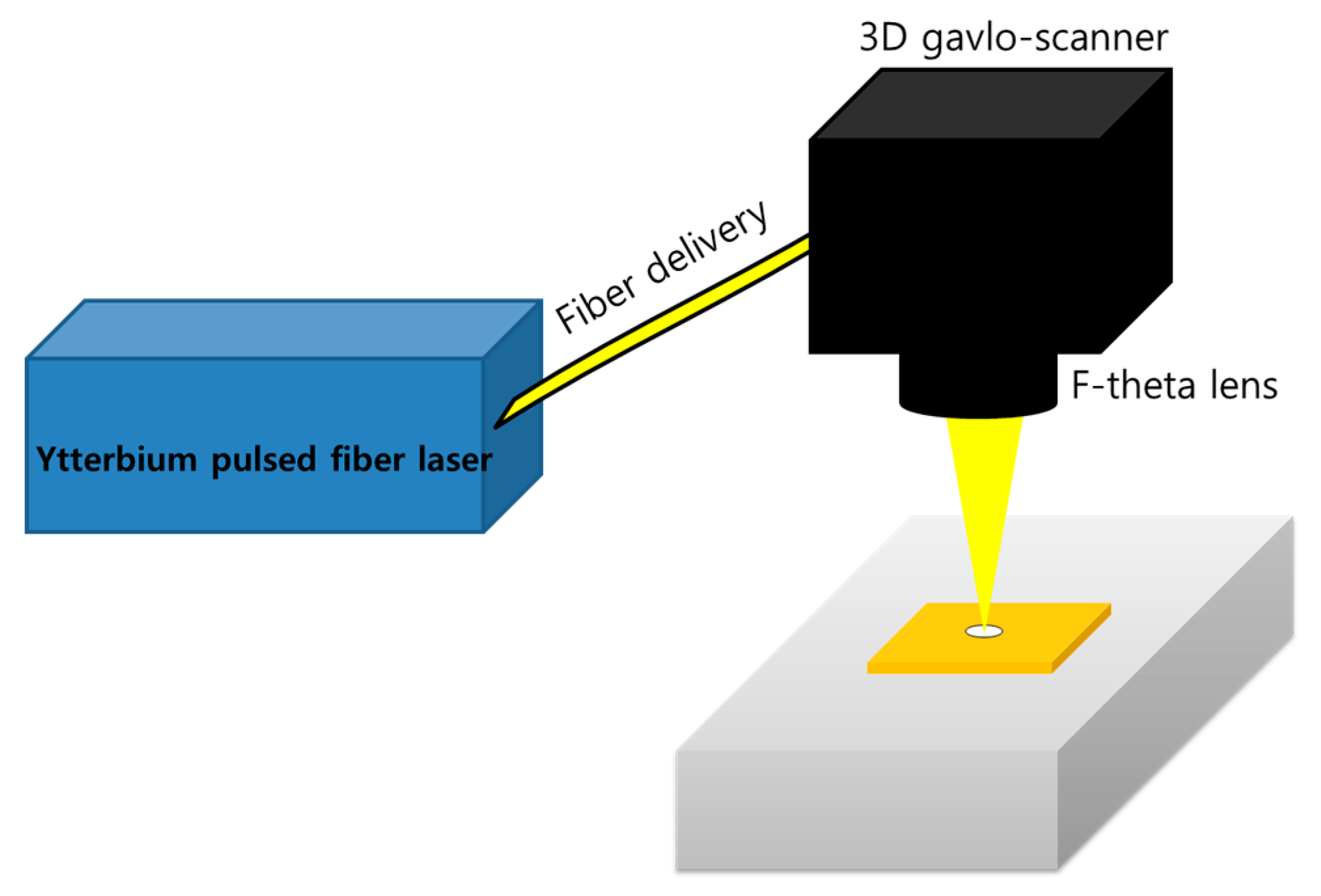
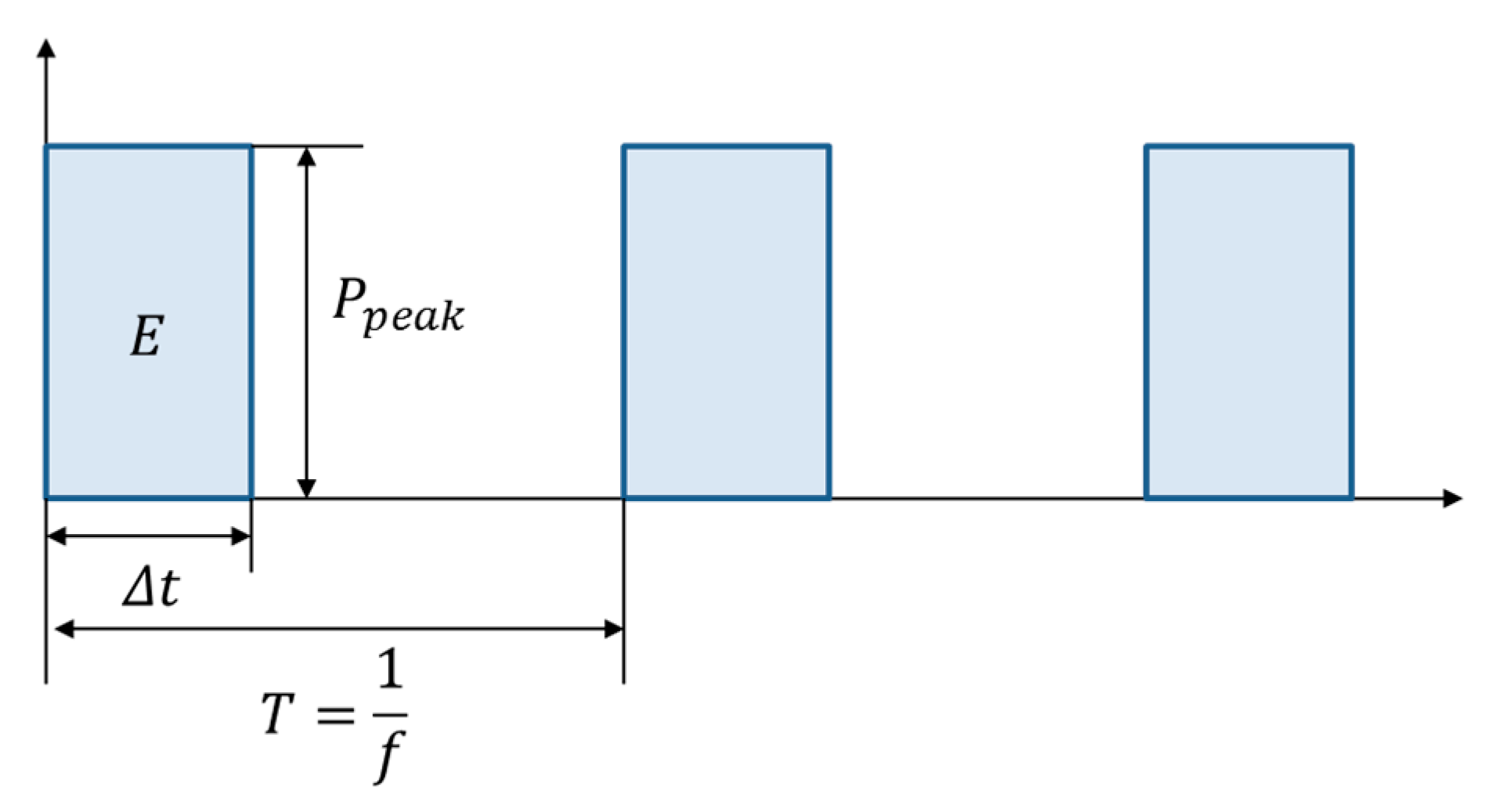
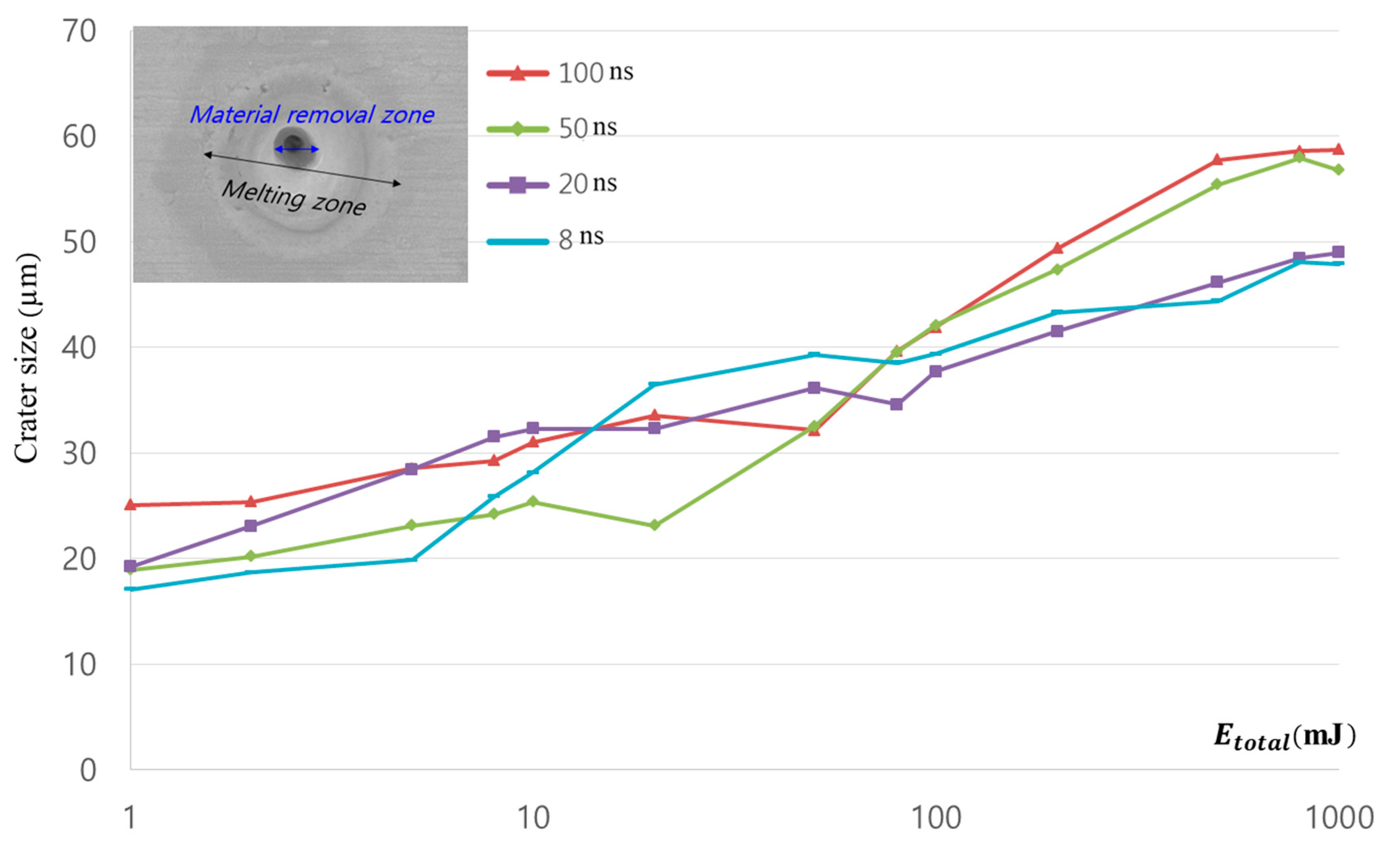
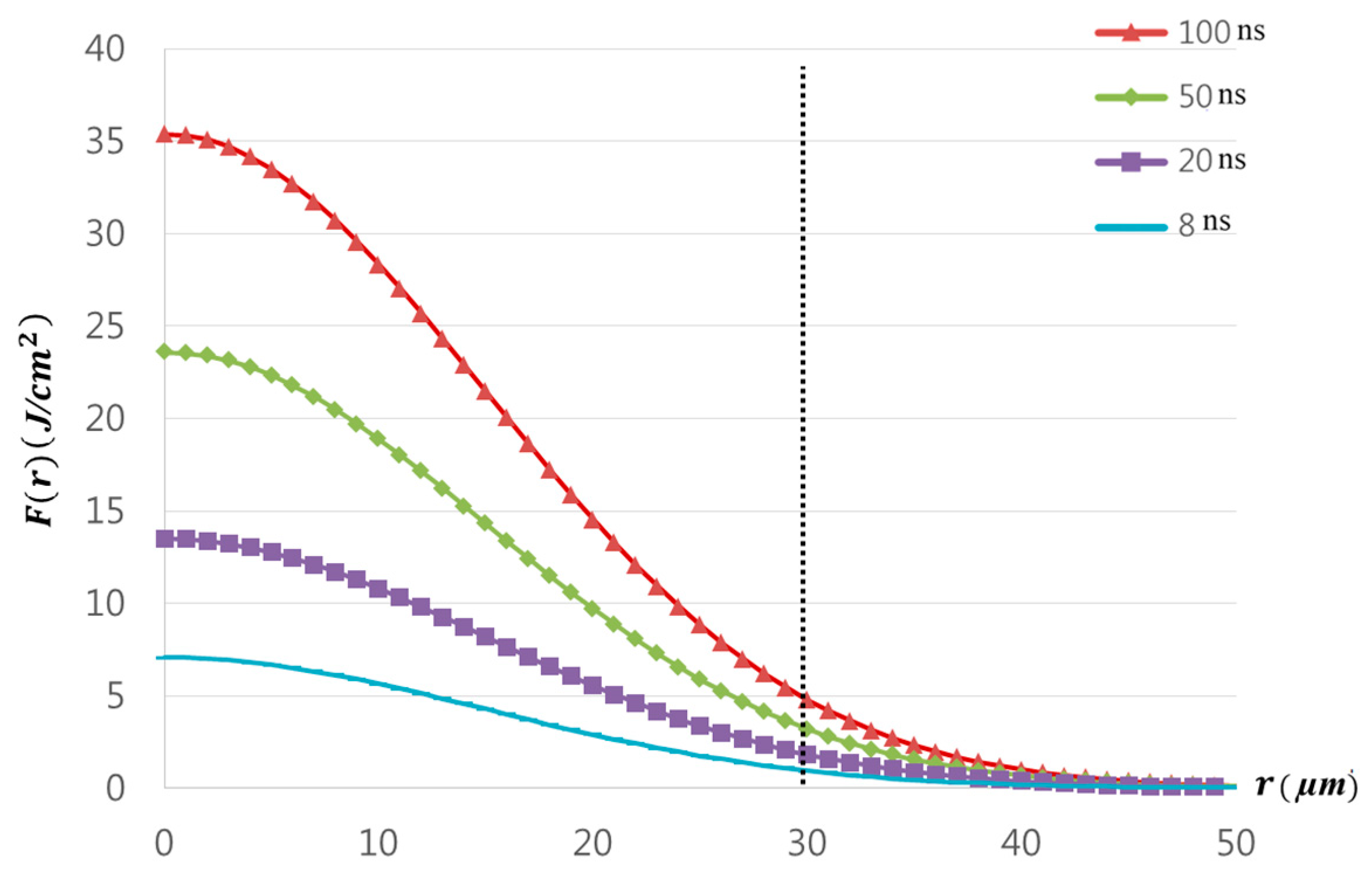
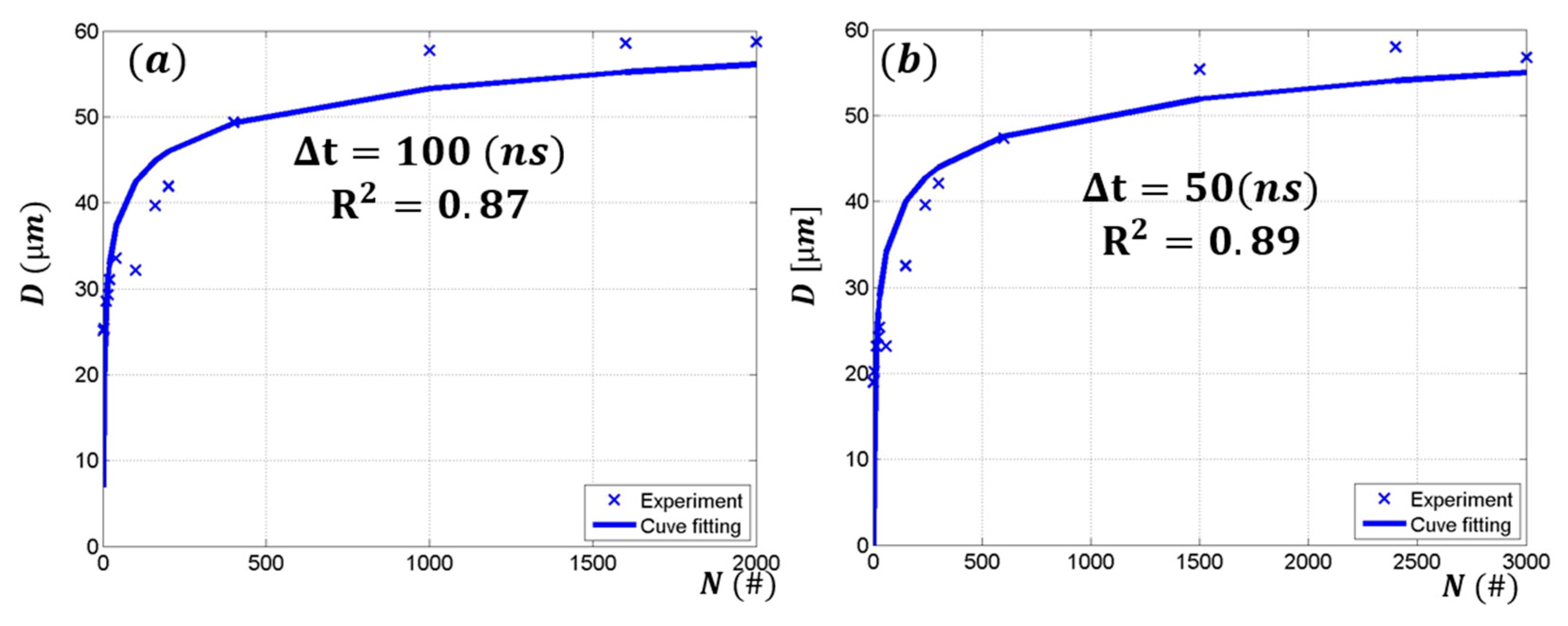
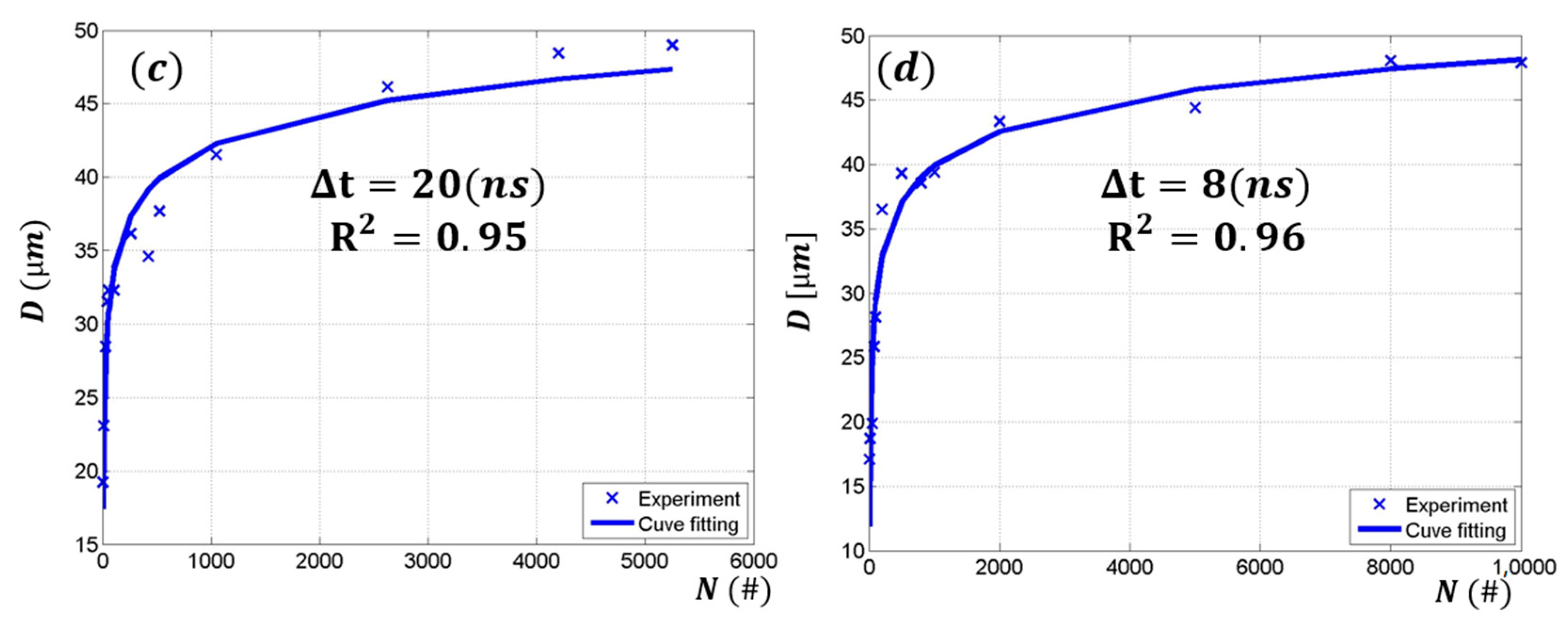

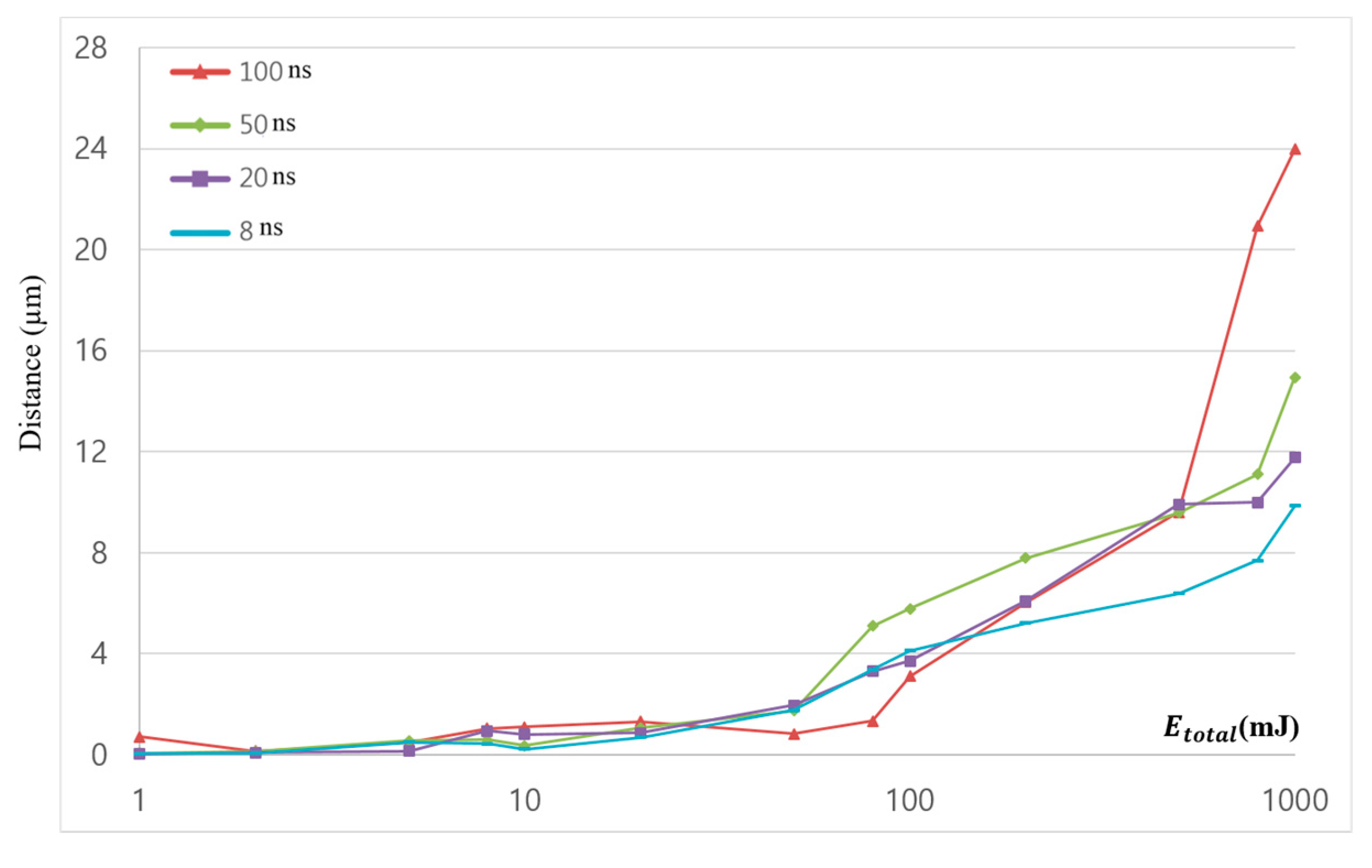
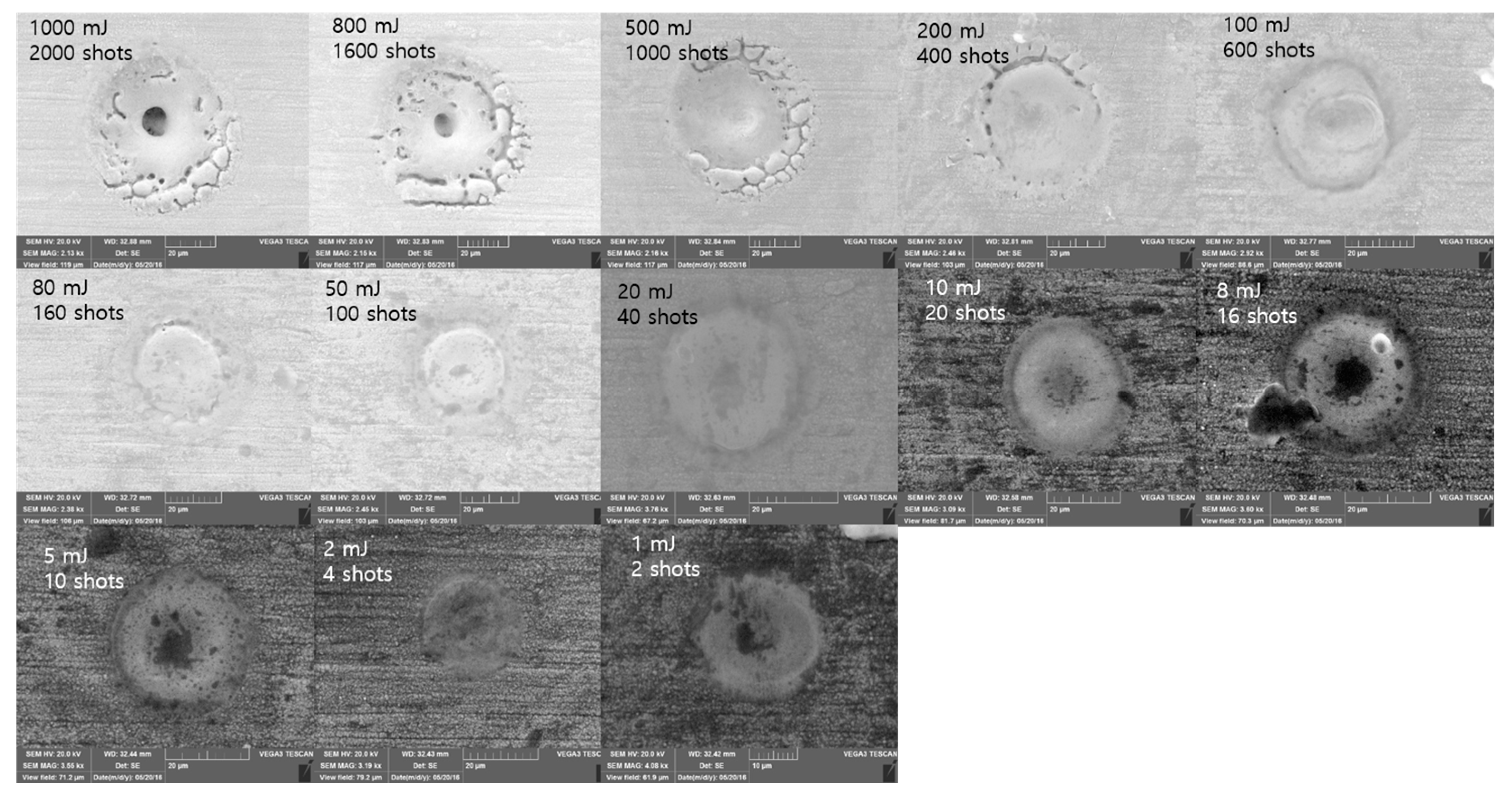
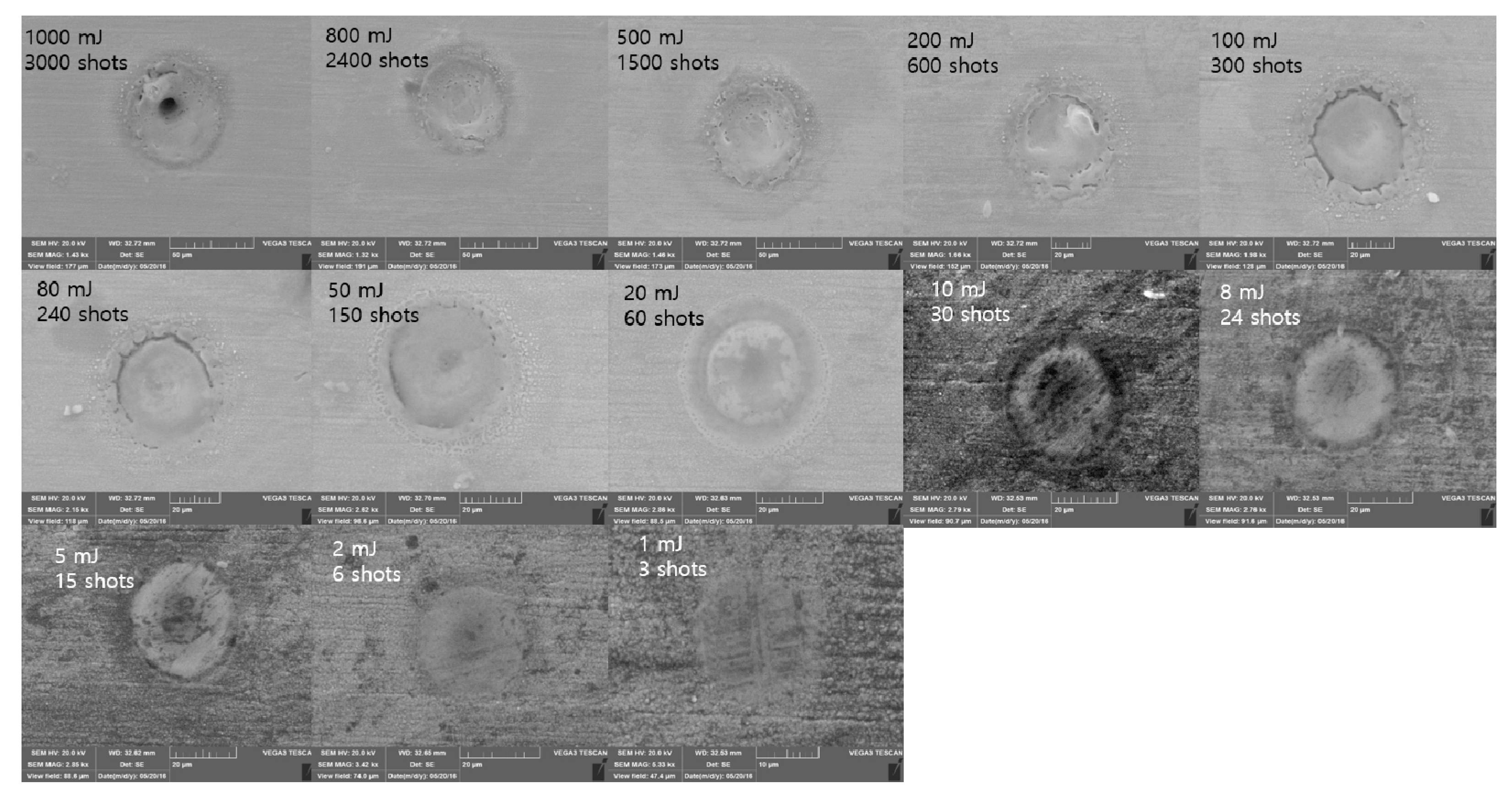
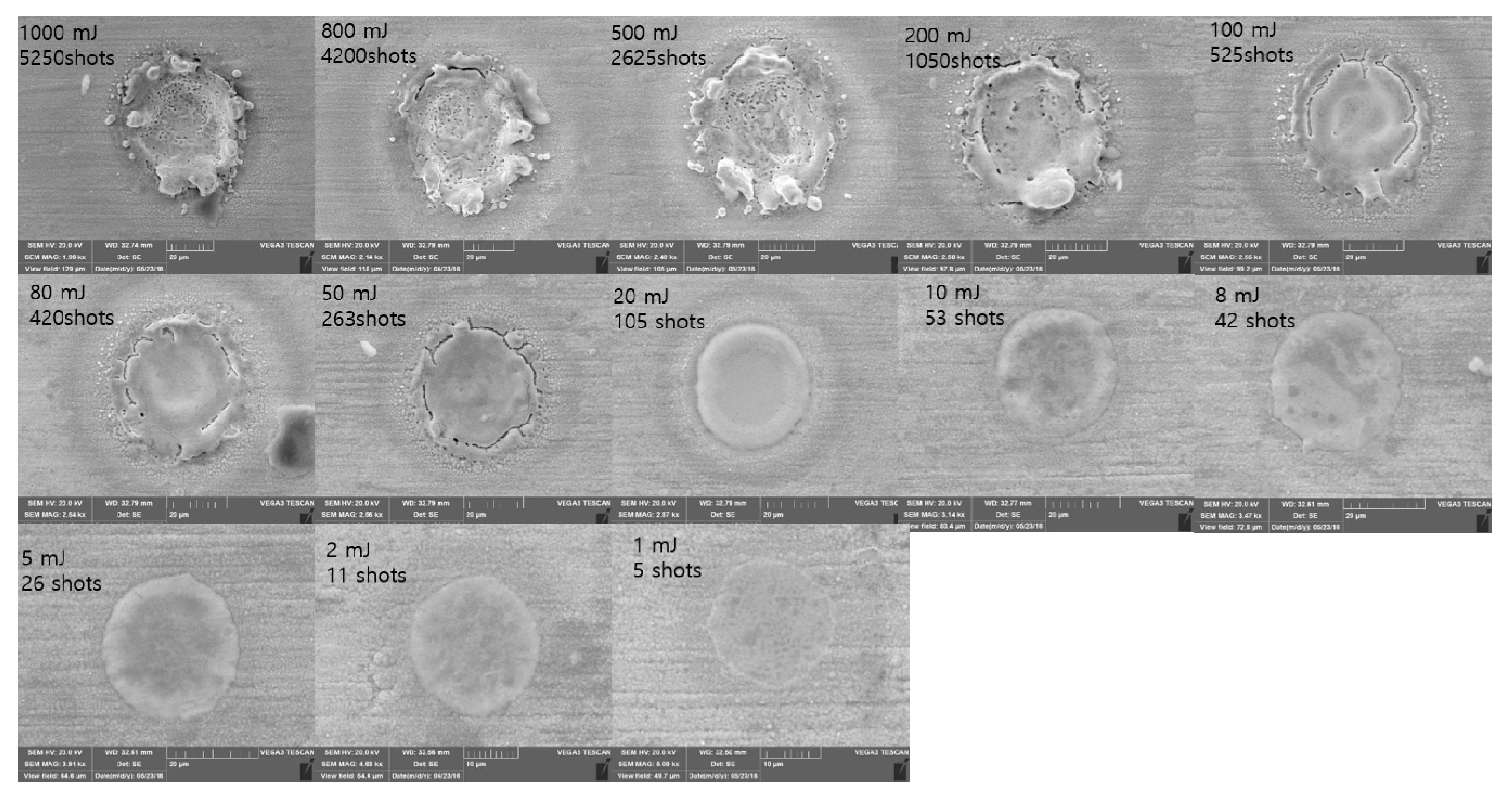
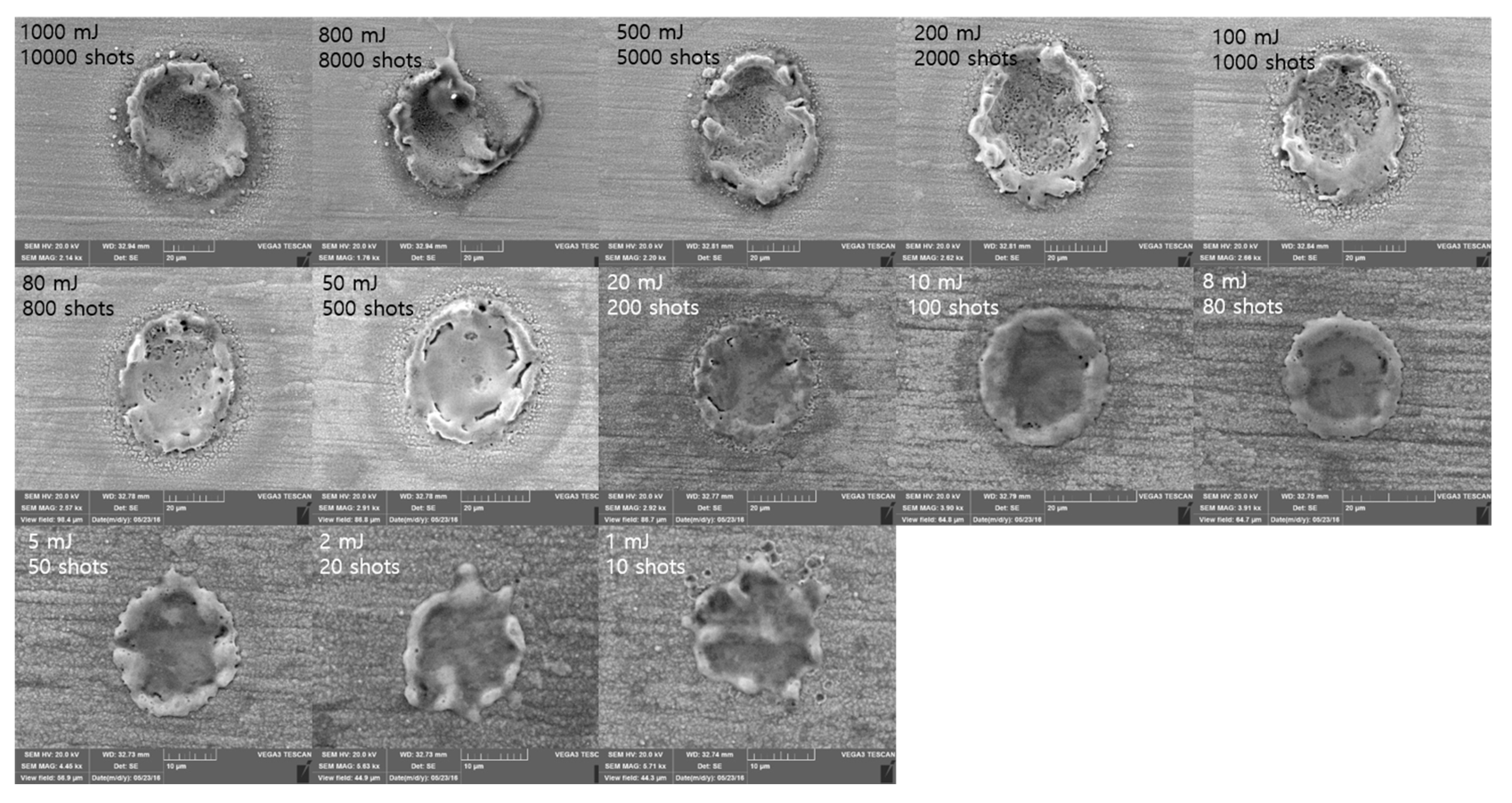
| # | Δt (ns) | f (kHz) | Pulse E (µJ) | Ppeak (W) | Total Energy (mJ) | ||||||||||||
|---|---|---|---|---|---|---|---|---|---|---|---|---|---|---|---|---|---|
| 1000 | 800 | 500 | 200 | 100 | 80 | 50 | 20 | 10 | 8 | 5 | 2 | 1 | |||||
| Number of Pulses (#) | |||||||||||||||||
| 1 | 100 | 40 | 500 | 5000 | 2000 | 1600 | 1000 | 400 | 200 | 160 | 100 | 40 | 20 | 16 | 10 | 4 | 2 |
| 2 | 50 | 60 | 333.3 | 6666.7 | 3000 | 2400 | 1500 | 600 | 300 | 240 | 150 | 60 | 30 | 24 | 15 | 6 | 3 |
| 3 | 20 | 105 | 190.5 | 9523.8 | 5250 | 4200 | 2625 | 1050 | 525 | 420 | 263 | 105 | 53 | 42 | 26 | 11 | 5 |
| 4 | 8 | 200 | 100 | 125,000 | 10,000 | 8000 | 5000 | 2000 | 1000 | 800 | 500 | 200 | 100 | 80 | 50 | 20 | 10 |
| 100 | 3.391 | 40.964 | 0.750 |
| 50 | 2.298 | 36.317 | 0.736 |
| 20 | 1.517 | 14.751 | 0.844 |
| 8 | 0.959 | 9.790 | 0.825 |
© 2018 by the author. Licensee MDPI, Basel, Switzerland. This article is an open access article distributed under the terms and conditions of the Creative Commons Attribution (CC BY) license (http://creativecommons.org/licenses/by/4.0/).
Share and Cite
Lee, D. Understanding of BeCu Interaction Characteristics with a Variation of ns Laser-Pulse Duration. Materials 2018, 11, 1423. https://doi.org/10.3390/ma11081423
Lee D. Understanding of BeCu Interaction Characteristics with a Variation of ns Laser-Pulse Duration. Materials. 2018; 11(8):1423. https://doi.org/10.3390/ma11081423
Chicago/Turabian StyleLee, Dongkyoung. 2018. "Understanding of BeCu Interaction Characteristics with a Variation of ns Laser-Pulse Duration" Materials 11, no. 8: 1423. https://doi.org/10.3390/ma11081423
APA StyleLee, D. (2018). Understanding of BeCu Interaction Characteristics with a Variation of ns Laser-Pulse Duration. Materials, 11(8), 1423. https://doi.org/10.3390/ma11081423





